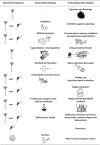Technological Microbiology: Development and Applications
- PMID: 28539920
- PMCID: PMC5423913
- DOI: 10.3389/fmicb.2017.00827
Technological Microbiology: Development and Applications
Abstract
Over thousands of years, modernization could be predicted for the use of microorganisms in the production of foods and beverages. However, the current accelerated pace of new food production is due to the rapid incorporation of biotechnological techniques that allow the rapid identification of new molecules and microorganisms or even the genetic improvement of known species. At no other time in history have microorganisms been so present in areas such as agriculture and medicine, except as recognized villains. Currently, however, beneficial microorganisms such as plant growth promoters and phytopathogen controllers are required by various agricultural crops, and many species are being used as biofactories of important pharmacological molecules. The use of biofactories does not end there: microorganisms have been explored for the synthesis of diverse chemicals, fuel molecules, and industrial polymers, and strains environmentally important due to their biodecomposing or biosorption capacity have gained interest in research laboratories and in industrial activities. We call this new microbiology Technological Microbiology, and we believe that complex techniques, such as heterologous expression and metabolic engineering, can be increasingly incorporated into this applied science, allowing the generation of new and improved products and services.
Keywords: biofactories; biopolymers; biotechnology; environmental microbiology; food microbiology; plant growth-promoting microorganisms.
Figures





Similar articles
-
Biotechnological Production of Pharmaceuticals and Biopharmaceuticals in Plant Cell and Organ Cultures.Curr Med Chem. 2018;25(30):3577-3596. doi: 10.2174/0929867325666180309124317. Curr Med Chem. 2018. PMID: 29521202 Review.
-
Biochemical and Biotechnological Insights into Fungus-Plant Interactions for Enhanced Sustainable Agricultural and Industrial Processes.Plants (Basel). 2023 Jul 19;12(14):2688. doi: 10.3390/plants12142688. Plants (Basel). 2023. PMID: 37514302 Free PMC article. Review.
-
Use of Temporary Immersion Systems in the Establishment of Biofactories.Methods Mol Biol. 2024;2759:25-41. doi: 10.1007/978-1-0716-3654-1_3. Methods Mol Biol. 2024. PMID: 38285136
-
Exiguobacterium: an overview of a versatile genus with potential in industry and agriculture.Crit Rev Biotechnol. 2018 Feb;38(1):141-156. doi: 10.1080/07388551.2017.1312273. Epub 2017 Apr 11. Crit Rev Biotechnol. 2018. PMID: 28395514 Review.
-
Enhancement of Plant Productivity in the Post-Genomics Era.Curr Genomics. 2016 Aug;17(4):295-6. doi: 10.2174/138920291704160607182507. Curr Genomics. 2016. PMID: 27499678 Free PMC article.
Cited by
-
Characterization of symbiotic and nitrogen fixing bacteria.AMB Express. 2022 Jul 30;12(1):99. doi: 10.1186/s13568-022-01441-7. AMB Express. 2022. PMID: 35907164 Free PMC article. Review.
-
Black soldier fly larvae (Hermetia illucens) strengthen the metabolic function of food waste biodegradation by gut microbiome.Microb Biotechnol. 2019 May;12(3):528-543. doi: 10.1111/1751-7915.13393. Epub 2019 Mar 18. Microb Biotechnol. 2019. PMID: 30884189 Free PMC article.
-
A novel GH3-β-glucosidase from soda lake metagenomic libraries with desirable properties for biomass degradation.Sci Rep. 2024 May 1;14(1):10012. doi: 10.1038/s41598-024-60645-y. Sci Rep. 2024. PMID: 38693138 Free PMC article.
-
Biotechnological potential of bacteria from genera Bacillus Paraburkholderia and Pseudomonas to control seed fungal pathogens.Braz J Microbiol. 2021 Jun;52(2):705-714. doi: 10.1007/s42770-021-00448-9. Epub 2021 Feb 16. Braz J Microbiol. 2021. PMID: 33594600 Free PMC article.
-
Plant extract mediated synthesis enhanced the functional properties of silver ferrite nanoparticles over chemical mediated synthesis.Biotechnol Rep (Amst). 2020 May 15;26:e00469. doi: 10.1016/j.btre.2020.e00469. eCollection 2020 Jun. Biotechnol Rep (Amst). 2020. PMID: 32477899 Free PMC article.
References
-
- Abdel-Fattah G. M., Shukry W. M., Shokr M. M. B., Ahmed M. A. (2016). Application of mycorrhizal technology for improving yield production of common bean plants. Int. J. Appl. Sci. Biotechnol. 4 191–197. 10.3126/ijasbt.v4i2.15103 - DOI
-
- Abdel-Gawad K. M., Hifney A. F., Fawzy M. A., Gomaa M. (2017). Technology optimization of chitosan production from Aspergillus niger biomass and its functional activities. Food Hydrocoll. 63 593–601. 10.1016/j.foodhyd.2016.10.001 - DOI
-
- Accinelli C., Abbas H. K., Little N. S., Kotowicz J. K., Mencarelli M., Shier W. T. (2016). A liquid bioplastic formulation for film coating of agronomic seeds. Crop Prot. 89 123–128. 10.1016/j.foodhyd.2016.10.001 - DOI
-
- Adedayo M. R., Ajiboye E. A., Akintunde J. K., Odaibo A. (2011). Single cell proteins: as nutritional enhancer. Adv. Appl. Sci. Res. 2 396–409.
Publication types
LinkOut - more resources
Full Text Sources
Other Literature Sources
Miscellaneous

